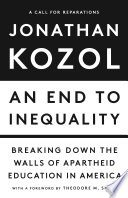 Summary: A brief book about the problems of education reform.
Summary: A brief book about the problems of education reform.
I picked this up because it was by Jonathan Kozol. I read several of his books in the 1990s and was a bit surprised that he had a new book out. Kozol turns 88 in Sept 2024 and his work on social justice and education should be celebrated. I am glad I read this because it was by Jonathan Kozol, but at the same time, if you are interested in the problems of education reform and especially how it negatively impacts Black or other racial minorities or poor students of all races, I would recommend Bettina Love’s recent book Punished for Dreaming: How School Reform Harms Black Children and How We Heal. I read it last year but did not write up my thoughts at the time because I was in a busy season. But it is a very helpful book that I think should be more widely read, not just among educators, but also among politically active people of all types of backgrounds.
An End to Inequality covers a number of different problems with public education from the physical environment (lead in water or paint, poor air circulation, heating, air, etc.) to curriculum to problematic reforms. I think one of the main themes of Bettina Love’s book is handled well here. Generally, testing of educational reform programs is done at poor or minority schools. Any testing of educational reform at predominately white and higher income public schools are reforms that give students more options or freedom. While the reforms at lower-income and minority schools are reforms that are focused on more highly structured teaching models, narrower academic ranges of subjects, or economic efficiencies. Said another way, reforms at predominantly white and upper-income schools are designed to help students have more enjoyment at learning and reforms at lower-income and predominately minority schools tend to reduce educational enjoyment.
The main problem with this first third of the book is that the examples are presented anecdotally, not systemically. I completely believe that everything that he reports happened, but there isn’t a structure to tell the reader how widespread these problems are or if they really are disproportionately impacting low-income and minority students. I think they are, I think there is plenty of evidence available in other sources to show that they are, but Kozol’s standard format is to tell stories of particular students or teachers and that story-oriented structure tends to lack statistical underpinnings.
As he moves toward the policy prescriptions I think he blames administration (which deserves a lot of blame) too much. Toward the end of chapter five (Models of the Possible), he suggests that it isn’t parents who oppose integration but administrators. This chapter largely recounts his time teaching in an optional school integration program in the 1970s. He had a supportive administrator who gave him flexibility with the curriculum and encouraged him to develop a love of learning. He describes what today would be called problem-based learning.
But I do think he is wrong about parents. While there are administrators who retrograde racial attitudes, I think the evidence is that parents play a significant role in maintaining segregation. School choice widens segregation. Parents’ perception of school quality impacts housing values, and those perceptions are significantly impacted by how many minority students are in the school. Kozol notes that diverse schools are known to have better overall learning outcomes than segregated education, but that isn’t the perception of parents. I think educators are likely to know that more than parents. However, like homework for elementary students, parents push for having elementary homework even as educators know it isn’t helpful and can be harmful.
I agree with Kozol that the movement toward educational integration has largely stalled and that continuing school segregation, regardless of the cause, does harm to students. I think his comments about reparations are under-supported but still important. I am a regular listener to Advisory Opinions, a legal podcast that primarily focuses on Supreme Court and higher-level judicial opinions. Over the past few years that I have been listening, there have been a number of cases that impact school integration or affirmative action cases. And the two (pretty conservative) podcasters agree that racial issues are real within education and other segments of society. But that affirmative action and desegregation systems were designed mostly around fairness in access, not reparations. And current movements to reduce affirmative action or desegregation system are based on raw fairness now, not on historic reparations due to harm. The legal system understands repair, but that is not how affirmative action was largely framed as it came into being. I think Kozol is right that we need to reframe education reform around reparations and repair rather than fairness, but that is an underdeveloped topic in the book that I wish he had addressed more fully.
I listened to the audiobook and it was just over three hours with a Q & A at the end. If it were longer I probably would not have finished it. Again, if you are interested in school reform and willing to read about the problems of school reform, especially in how the reform movement can negatively impact students, read Punished for Dreaming instead.